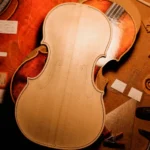What Is A Good Violin Made Of? The Amazing Art Of Violin-Making
Back to BlogWhile only a handful of violins made by great masters have stood the test of time, it is important to know what makes them special. But how can you tell if it is a good violin? There are some aspects you will find in the composition of these masterpieces. Materials and craftsmanship are undoubtedly the most important ones!
Now, in this blog, we’ve selected the key topics so you can learn how to identify a good violin and get to know more about the amazing art of violin-making. The aesthetics of a violin are important but more of a matter of taste than quality. If you are a beginner, know that once you know a few basics about violin construction, you will be able to make a good buying decision and provide your student musician with a violin that will offer years of playing and enjoyment.
The Materials and Bases influence the violin-making
Marked by their incomparable elegance, sound, and characteristics, a good stringed instrument will have the quality from the very beginning of its making. The selection of the materials and base is essential in violin-making, depending on the kind of wood the maker picks, the sounding results will be different.
The wood choice is made according to their resonant qualities. Every time the bow touches a string, the entire instrument vibrates. Friends may tell you that as you play more and more concerts with your symphony, your violin will open up and “sound better” – which is completely true. The more you play the more the wood is dry therefore giving a crystal clear sound to the violin.
There’s one thing you must remember about violins: it’s all about the sound of the music. Any kind of instrument needs to deliver a good tone for musicians to be happy with their choice. The wood, the materials, and fittings will influence a lot at the final result and they are crucial to building your instrument’s voice. For that reason, not just the crafting method, but everything involved in the making of a masterpiece will be of the highest quality.
The table (top) of a violin is often made from spruce, making it strong enough to retain its integrity and flexible enough to be shaved to very thin thicknesses.
Another thing interesting to look at is the back! The wood flames at the back, those marks that sometimes can look like tiger stripes or simply create curious drawings, indicate the artwork of nature, which means the wood chosen has quality.
Craftsmanship, the amazing work of the luthiers, makes a good violin, a masterpiece!
A handmade violin is a product of the hands of a maker, who spends more time creating it than those working at large-scale production facilities. Just as in any other profession, the maker must study, attend violin-making school, practice for years in a workshop, and receive mentorship, among other things to finally come up with their work of art.
The first time you see a handmade violin, it’s hard to guess what to expect. The craftsmanship is obvious in each detail, and the resulting sound is beautiful but different from the sound of other violins.
“It is important not only to study and observe the instrument, but also the maker and the life they had. With a greater knowledge of the maker, we can understand what they were looking for at the time they were creating the instrument” Luiz Amorim
The seams of any stringed instrument should be carefully sealed, with no rough edges or visible signs of glue. A finely carved scroll indicates the maker’s high level of craftsmanship. Each handmade violin has a distinct personality. When a luthier makes a violin, he/she carefully selects and prepares each piece of wood. He/she understands the art of varnishing and is skilled in instrument making. A luthier creates a timeless treasure when he/she makes your violin.









